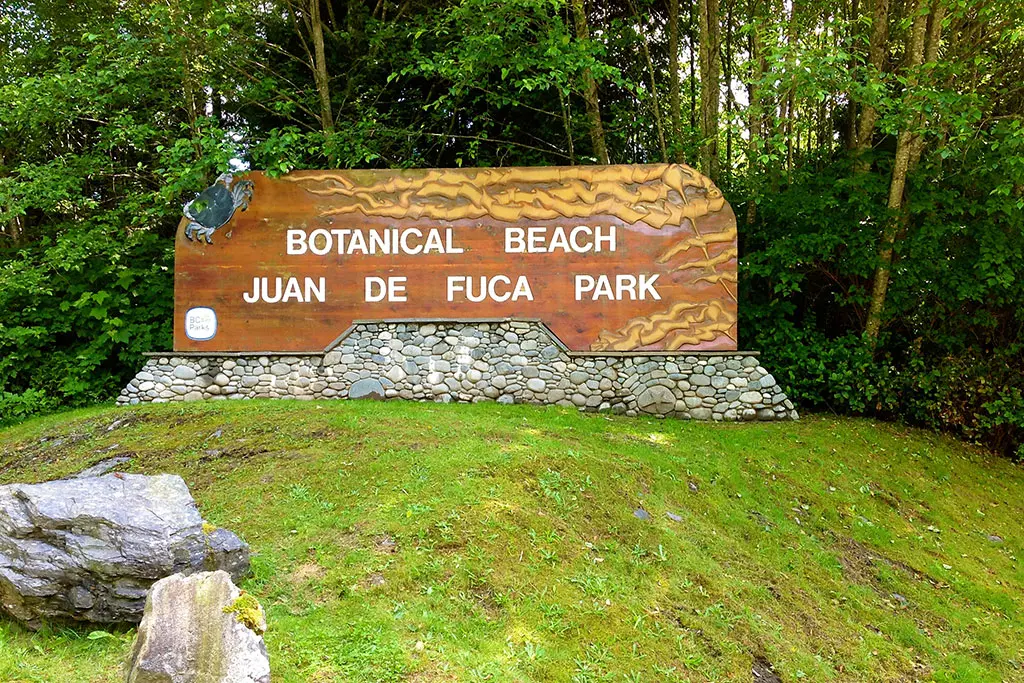Location:
Botanical Beach is located only a short 5 min drive from Handsome Dan’s Cottages, or 115 km, and approximately a 2hr 10min drive from Victoria
Some Info about Botanical Beach:
Visiting Port Renfrew and not hiking at Botanical Beach would be like visiting New York City and not going to the Statue of Liberty. Botanical Beach and nearby Botany Bay can be accessed at the end of Cerantes Road from the large roundabout parking lot in the Juan de Fuca Provincial Marine Park which includes a great nearby picnic table area. Botanical Beach offers one of the best opportunities to view intertidal marine creatures and plants on Vancouver Island. The area is a protected zone, so please take nothing but photographs.
To Get the Best of your Visit: Plan it at low tide and check the Port Renfrew Tide Chart
What to wear: Wear water-resistant shoes with sturdy soles as the going is always wet. Even during the lowest tides of the year – December and January, June and July The prospect of being caught out here will make your adrenal gland flutter.
Parking Lot:
At the parking lot you will find two trailheads. One leads to Botanical Beach and the other to Botany Bay. The trail is a loop trail, so no matter which you choose, it will return you to the parking lot. See the picture of the trail above. The complete loop is 2.7km. From the parking lot, Botany Bay is 0.7km to a set of stairs that will lead to the beach and into the Bay. From here you have a choice, you may do the Beach to Beach trail, or do the loop trail.
- Beach To Beach Trail: Only attempt this at low tide. Be sure to check the Tide Chart. Follow the stairs and go down into the Bay where you can hike towards the left (south) from Botany Bay along the rocks to Botanical Beach and explore all the tidal pools on the way. It is truly spectacular. Some rock climbing is involved, nothing too crazy, but I do not suggest it for young kids and elderly people. Remember to stay back from the high tide points and keep your eyes peeled for rogue waves. They are exciting and fun to watch from a distance, but are dangerous close up. Although you wouldn’t want to be anywhere near here at high tide, it’s staggering to imagine how conditions must boil in there during winter storms.
- The Loop Trail: Great choice if the tide is high, or if some people in your party like to do the beach to beach way, and you rather have a beautiful pleasure walk into the rainforest. Do the trail from the top of the stairs. This will lead you to Botanical Beach as well, and eventually back to the parking lot. The trail is absolutely beautiful. There are many great ocean vista view points to look down onto the beach as you travel the trail, which is perfect for storm watching in the winter months.
- Tide Pools: Botanical Beach is known for its Tidal Pools, the Great Botanical Loop Trail, Storm Watching in the winter months and an abundance of Wildlife. It is one of the most amazing places on the entire West Coast, particularly at low tide.
This is when visitors can walk a long way out across flat sandstone and granite outcroppings to view tide pools filled like jewel boxes with brightly coloured marine animals. Purple, red and orange starfish and sea urchins, blue mussel shells, white gooseneck barnacles, green sea anemones and sea cucumbers. So significant is this location that a research station was first established here in 1900 by a team from the University of Minnesota.
The organisms that live here must be able to handle a wide range of conditions. When the tide is out there are significant changes in temperature, predators, food sources and salinity. Each creature has adapted to contend with these variable conditions.
Organisms that cannot cope with drying will survive in the tide pools or in shaded crevices. There you will find Sea Stars, chitons and anemones. The Sea Stars often pile together to reduce moisture loss. Barnacles, snails and mussels are able to survive by closing up tightly with a small amount of water inside their shells. Purple sea urchins have established a particular niche in the soft sandstone. Their sharp, hard spines help to wear away the indentations in which they live.
If you have the chance, do both trails. They are truly spectacular. And the beach to beach with the tidal pools is a must.
- Wild Life: Killer Whales and Grey Whales have often been observed swimming past the beach or feeding just off of the point. The best time for seeing Grey Whales is during their migration from the Mexican coast to Alaska during March and April. Sea lions can be found here from late August through May.
-
Bear and Cougars:Remember this is bear and cougar country so please take the usual wildlife precautions.Safety:
Why Botanical Beach is a MUST visit: Botanical Beach, located on the southwestern coast of Vancouver Island, is a captivating natural wonder that beckons visitors from near and far. Here’s why you should add this breathtaking destination to your travel itinerary:
**1. Tide Pools Galore**: Botanical Beach is renowned for its extensive tide pools, which are teeming with an incredible diversity of marine life. During low tide, the rugged shoreline unveils a mesmerizing world of colorful sea stars, crabs, anemones, and other fascinating creatures. It’s like stepping into a natural aquarium where you can observe marine ecosystems up close.
2. **Unique Geological Formations**: The beach is adorned with unique geological formations, including sea caves, arches, and towering rock formations carved by the relentless forces of wind and waves. These dramatic features create a stunning backdrop for photography enthusiasts and nature lovers alike.
3. **Botanical Wonders**: True to its name, Botanical Beach is home to a rich array of coastal plant life, including rare species that thrive in the unique microclimate of the area. The coastal rainforest surrounding the beach is a botanical paradise, offering a glimpse into the diverse flora of Vancouver Island.
4. **Scenic Hiking Trails**: Explore the coastal trails that meander through lush forests and along rugged cliffs, offering spectacular panoramic views of the Pacific Ocean. The Juan de Fuca Marine Trail, which passes through Botanical Beach, provides opportunities for both leisurely strolls and challenging hikes, allowing visitors to immerse themselves in the pristine beauty of the surrounding wilderness.
5. **Educational Opportunities**: Botanical Beach is a designated Provincial Park and ecological reserve, offering educational programs and interpretive displays that highlight the importance of marine conservation and biodiversity. Visitors can learn about the delicate balance of coastal ecosystems and the efforts to preserve these precious natural habitats.
6. **Whale Watching**: The waters off Botanical Beach are frequented by majestic marine mammals, including orcas, humpback whales, and gray whales. During certain times of the year, lucky visitors may catch a glimpse of these magnificent creatures breaching and spouting offshore.
7. **Peace and Serenity**: Away from the hustle and bustle of urban life, Botanical Beach offers a tranquil retreat where visitors can reconnect with nature and find solace in the soothing sounds of the ocean. Whether you’re seeking adventure or simply craving a peaceful escape, this pristine coastal gem has something for everyone.
In summary, Botanical Beach on Vancouver Island is a must-visit destination for nature enthusiasts, photographers, hikers, and anyone who appreciates the raw beauty of the natural world. With its rich biodiversity, stunning landscapes, and educational opportunities, it promises an unforgettable experience that will leave you with lasting memories of Vancouver Island’s rugged west coast.

